| A new release of Redhat-sponsored Fedora is always in the headlines of the Linux world as it is one of those distributions that push Linux forward by introducing exciting new features. Fedora has always been something like a test platform for Redhat's commercial product, the Enterprise Desktop/Server, however recently we have seen some changes suggesting that Fedora has decided to mature and try to become a good alternative for the average Linux desktop user. I have used Fedora 7 for about 4 months myself until I moved over to Arch Linux so in this review I will try to point out what has been improved other the older versions. |

Installation
To install Fedora 8 I decided to download the Gnome liveCD that includes a hard disk installer. The full DVD uses Redhat's Anaconda installer so expect excellent hardware detection and easy installation. The liveCD install was pretty easy as well, it just offers you some basic options, partition options and root password and then copies the image to the hard disk. It took about 10 minutes to install in my system. After installation and during the first boot you will meet yet another wizard in order to set some more settings like network, firewall, SELinux and finally add a normal user. Complete that and you are right at your new Fedora 8 desktop.
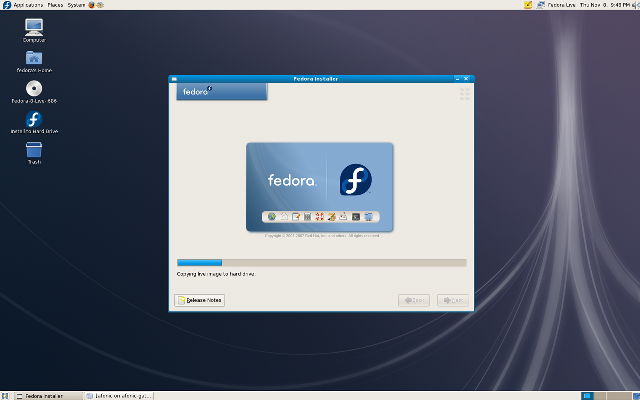 |
| Installing Fedora 8 using the liveCD installer. (click for full size image) |
Usage
First impression / Looks
The first think I noticed after booting Fedora for the first time is the amazing new look. Fedora is one of the distros that didn't care about looks originally but with the two last releases they have done a great job. Both the boot image and the login screen and very polished. After you login you can see the new default wallpaper (which is much better than the one in Fedora 7 in my opinion) which actually consists of many different colored images that swap depending on the time of the day. A pretty good idea don't you think? The new Gnome theme called Nodoka is also very polished as they have kept all nice looking features from Fedora 7 and improved the rest, for example the Metacity theme. Compiz Fusion is also installed by and can be easily enabled in systems that support it out of the box. For the rest you still need to do some work as I'll explain below. To sum it up, I feel that Fedora 8 is an aesthetically pleasing distribution, looking very professional and polished at least in the Gnome desktop (I haven't tried KDE but from the screenshots I could say it looks quite good too).
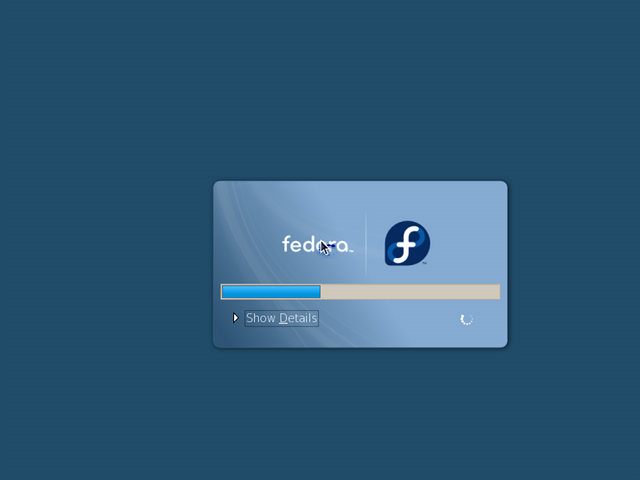 |
| The new boot screen. |
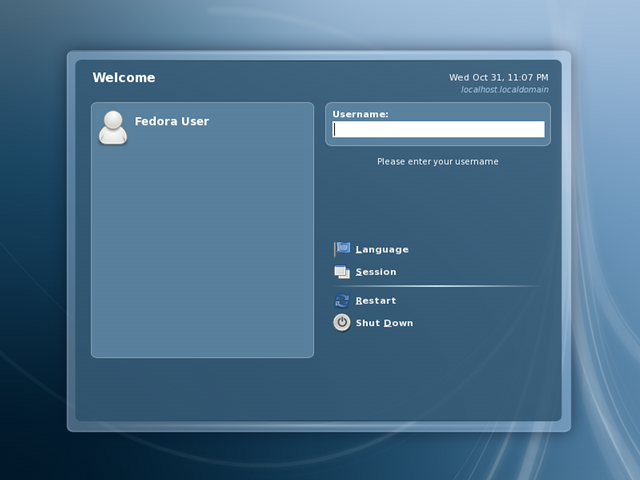 |
| The login screen theme. |
Usage / Configuration
Fedora 8 is the first distribution that not only worked fine with my Geforce 8800GTS but found and configured my new widescreen monitor using the right resolution of 1680x1050. However it uses the open source nv driver, so I had to install the closed source nvidia driver in order to use Compiz. Unfortunately even though Fedora has a graphical tool for configuring the X server and includes the simple tool first shown in Ubuntu to enable Desktop effects (Compiz) neither of those inform you that you need restricted drivers in order to fully use your hardware. The solution is pretty simple, you have to add the Livna repository and install the nvidia-kmod package that will provide you with both the nVidia driver and a nice little tool in order to enable AIGLX compositing. However even though the solution is simple I think that Fedora should use something like Ubuntu's Restricted Drivers tools in order to inform the user what they need to install in order to use hardware which is not supported by open source drivers.
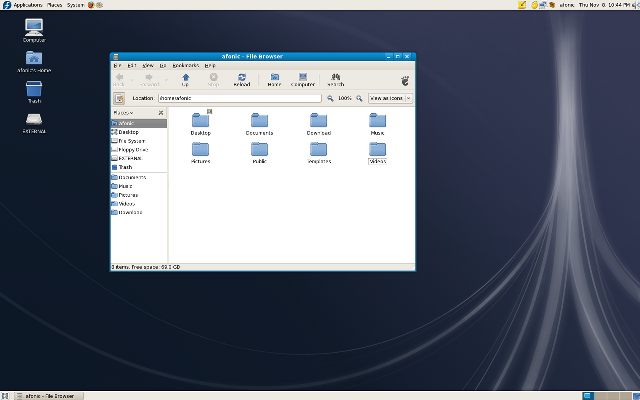 |
| The beauty: The new art made for Fedora 8 is simple awesome. Everybody likes eye candy right? (click for full size image) |
Fedora does not include any kind of control panel but has some utilities to control settings like the firewall, SELinux, users and groups, system services and more. The system uses 2.6.23 Linux kernel and Gnome 2.20.1. Preinstalled you will find the usual pack of applications that come with the Gnome desktop, for example Mozilla Firefox, Evolution, Pidgin, Totem and Tomboy notes. Strangely enough the liveCD does not come with OpenOffice 2.3 but with Abiword and Gnumeric instead, probably due to limited space. Great for me as I usually remove OpenOffice and install those two anyway! Another pleasant surprise has the inclusion of Transmission by default. Transmission is a lightweight GTK-based BitTorrent client, one of the best out there and much better than the Gnome Bittorrent client that is offered in other Gnome distros like Ubuntu. I also found a cool blog utility installed that lets you post to your blog from your desktop (it supports most well known sites) as well as a "Phone manager" that seems to deal with mobile phones which however I couldn't test as I use an old Nokia 2600 as it is the only one that won't die after kicking it around or throwing it off you pocket for fun. :)
One interesting new feature in Fedora 8 is the fact that PulseAudio is now installed and enabled by default. In the release notes you can learn that "PulseAudio allows for hot-switching audio outputs, individual volume controls for each audio stream, networked audio, and more". In simple words? No more fighting between your applications for which gets to use your sound card, plug your USB headsets and play (not pray). This is probably something all major Linux distros will use sooner or later and it is nice to see it in Fedora. I was also pleased to see that ntfs-3g was pre-installed, allowing read/write access to my external hard disk which uses that file system.
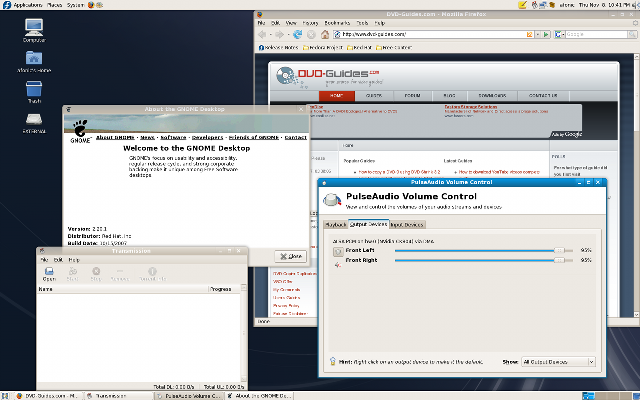 |
| Fedora 8 running Firefox, PulseAudio config and Transmission. (click for full size image) |
Multimedia / Package management
Fedora uses .rpm format and the yum package manager. Although many people dislike RPM based distros (especially those that had to use them in the old times and got through the dependencies hell) things have improved. Package management in Fedora is solid and especially in Fedora 8 *fast*. Speed has improved a lot since the last version something that becomes very obvious to old Fedora users. Generally the package management is working really well as well as the graphical tool and the update manager, so there was nothing that left me unsatisfied.
In the other hand multimedia support is lacking badly. Fedora has included a new tool they call "CodecBuddy" that is supposed to take care of codec installation. Fantastic. But does it work? Well it turns out it doesn't work. First I tried to play an mp3 file, so easily enough the codec program told me I needed extra plugins and asked me to install Fluendo mp3 plugin which I did. So far so good. Next came an .avi file with XviD codec. Codec buddy came up again and told that to see that movie I had to get "MPEG Playback Bundle". This could be nice if that bundle didn't *cost* $16! You beg I pardon? Well as it turns out that "CodecBuddy" thingie is a program made by Fluendo and its main purpose is making Fluendo money. I can't understand why it points me to buy something when I am trying to play a file encoded with the open source "Xvid" codec. Next I tried playing a .wmv file. Well it turns out you can't play .wmv files in Linux as CodecBuddy failed to find something I can get in order to playback my movie.
Don't get me wrong I understand the reasons and the philosophy behind the fact that many distributions do not include these codecs. I am the last that would ask to include them by default. But Fedora has created a little beast here. Instead of some nice wiki page with instructions they included an application that doesn't work and when it does it insists that the user needs to pay in order to play his files. Sure open source formats are superior and users should be educated in order to use them, but many files out there use restricted formats and we should try to make it easy for them to play them under Linux. "CodecBuddy" is a complete disaster that should have not been included in Fedora 8. The developers should look at openSUSE 10.3 and Ubuntu to see how codec installation should be implemented.
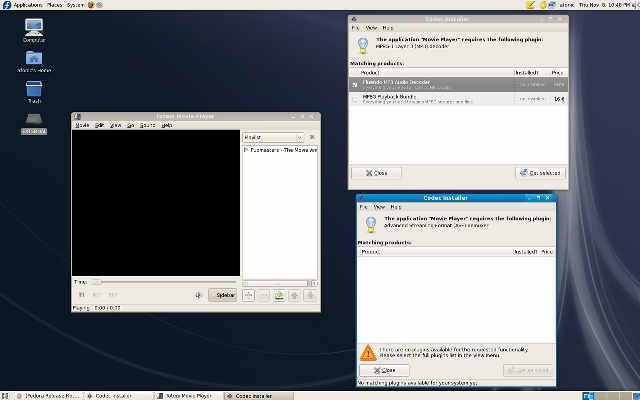 |
| The beast: CodecBuddy decides I can't play wmv in Linux. Right above it asks me to pay $16 in order to play an XviD file. (click for full size image) |
As for the solution to that mess? Just do it the old ways. Ignore CodecBuddy and open up the package manager to download and install the necessary packages from Livna repository. In the other hand Flash can be installed just by visiting Abode's site as they offer the option to add a yum repository and the follow the instructions there. However there is not a way to inform user to do that as when Firefox finds Flash in a page he opens the plugin wizard, downloads the plugin and... fails.
Conclusion
There is no doubt Fedora 8 is an excellent distribution. Redhat is a major contributor to Linux and you can see that in Fedora which includes many exciting new features. Fedora 8 is very stable, the package management is one of the best out there, security is tight as always and finally the presentation have improved to make one of the best looking Gnome distributions I have seen. However in the eyes of the average desktop user Fedora fails miserably. He will have to go hunting for third party repositories to get nVidia or Ati drivers installed and then get confused by the new codec tool. He will even have to go searching the web to find out why Flash fails when trying to install it in Firefox.
I consider myself an advanced Linux user that know his way around. Is Fedora right for me? I love it. Would I suggest it to a new Linux user or your average Joe? No way. Thats not necessarily a bad thing but I have decided that I would write these reviews from they eyes of a simple Linux user, one that likes free software and want to stop using Windows. Fedora 8 is great, not for the masses though.
Read the rest of my Linux distributions reviews.


Comments
Bottom Line you can circumvent that nasty program if you look hard enough. I have tried alot of distros and the 2 that stand out above all else are Ubuntu and Fedora. Fedora is my preferred distribution but not due to its superiority over Ubuntu or any other distro but because it is what I am familiar with.
Just a side note the money generated by CodecBuddy is supposedly used to pay for rights to legally install codecs for closed source codecs. Of course a small amount goes to the author of the program but it is supposed to be that most of it pays for licensing
I have installed the mysql 5.0.45, then apache 1.3.41, then PHP 5.2.5.
Now, After installation, I have made the necessary changes in httpd.conf, php.ini., and created the index.php.
Now, I have run the Localhost page so, I am able to see the home page of Apache. but not the full info of PHP.
It is showing some error like Cannot load /usr/local/http d/modules/libph p5.so into. and
server: /usr/local/http d/modules/libph p5.so: cannot restore segment prot after reloc: Permission denied
Can you suggest me how to solve this issue.
Why not try installing Xine to play all media formats. I have always done it with all major Red Hat Destros. its great.........i t works fantastic....mo re importantly its free. Why to look for seperate plugins and codecs. just untar, ./configure, make, and make install. make clean. And there you are.....
"As a matter of fact none of the major distros include non open source drivers."
Uh, is Mandriva no longer a major distro?"
Umm.. Sabayon is ranked 5th on distrowatch... been providing non-open source drivers since ages. It was also the official beryl-project distro, and that's for a reason!
Uh, is Mandriva no longer a major distro?
Heck, have you ever heard a Windows user PAY to watch an XviD movie? They just go and downloaded the codec.
You say that you can't see something Fedora has and others don't. Looking from the eyes of an advanced user I can't see something others have that Fedora doesn't.
You say that for more advanced users, Fedora is great. Please explain. I am an advanced user, and I see no clear advantages to using Fedora over any other distro. Can you quantify your statement with facts?.. Be specific too. What precisely does Fedora offer that the others dont? Is Fedora faster than all the others?.. Is it more tailorable?..
There is a very good reason for why Distro's evolved away from Red Hat. That reason has never changed, and is still just as valid today, as back then. Red Hat is still only suitable for Developers and backroom geeks. It still caters to that minority crowd, while the real Open Source majority Linux world moves on past it. They attempt to FORCE a philosophy on potential users rather than offer them an educated choice with alternatives. They are doing this through vendor lockin with Codec Buddy, which is even worse. Bad move.
As I said above I understand the philosophy behind not including drivers and I respect it. As a matter of fact none of the major distros include non open source drivers. But including a tool to *install* restricted drivers is not illegal by the way thats why I said it should be added in order to help Fedora to keep up with the other desktop Linux competitors. As the other distros get easier, Fedora remains the same, something that could eventually move Fedora to a status of a "enthusiast" distro and not one widely used. Again as I said in the review this is not necessarily bad but I get the feeling the Fedora folks are aiming for a wider user base.